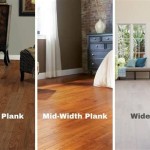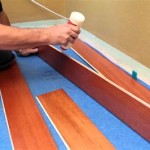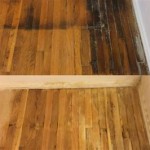Black and White Bathroom Vinyl Flooring: A Timeless and Practical Choice
Black and white bathroom vinyl flooring represents a design choice that transcends fleeting trends, offering a classic aesthetic with inherent practicality. The combination's versatility allows it to complement a wide range of bathroom styles, from minimalist modern to elaborate Victorian. Furthermore, vinyl's inherent properties make it an ideal material for the moisture-prone environment of a bathroom, presenting a cost-effective and durable alternative to other flooring options.
This article aims to provide a comprehensive overview of black and white bathroom vinyl flooring, exploring its design possibilities, practical advantages, installation considerations, and maintenance requirements. It delves into the various patterns, textures, and styles available, enabling informed decision-making for homeowners and designers considering this flooring option.
The Enduring Appeal of Black and White Design
The enduring appeal of black and white as a design scheme lies in its inherent contrast and visual impact. The stark juxtaposition of these two colors creates a sense of drama and sophistication, capable of elevating the aesthetic of any space. In the context of bathroom design, black and white flooring provides a strong foundation upon which to build a cohesive and stylish environment. The simplicity of the color palette allows for flexibility in incorporating other design elements, such as colorful accessories, textured walls, or intricate fixtures.
The versatility of the black and white combination extends to its adaptability to different design styles. In a modern bathroom, a large-format black and white tile pattern can create a clean and contemporary look. Conversely, a smaller, more intricate pattern, such as a checkerboard or mosaic design, can evoke a more traditional or vintage feel. The key is to carefully consider the scale, pattern, and finish of the vinyl flooring to achieve the desired aesthetic.
Beyond its aesthetic appeal, black and white flooring can also contribute to the perception of space. Lighter colors, such as white, tend to reflect light and make a room appear larger and more open. Conversely, darker colors, such as black, can absorb light and create a sense of intimacy and warmth. By strategically using black and white in the flooring design, it is possible to manipulate the visual perception of the bathroom's size and shape.
Practical Advantages of Vinyl Flooring in Bathrooms
Vinyl flooring is a popular choice for bathrooms due to its inherent practical advantages. Unlike hardwood or natural stone, vinyl is inherently water-resistant, making it an ideal material for environments prone to moisture and spills. This water resistance prevents the flooring from warping, rotting, or developing mold and mildew, all common problems encountered with less suitable flooring options.
Furthermore, vinyl flooring is relatively easy to clean and maintain. Its smooth, non-porous surface resists stains and spills, and can be easily wiped clean with a damp mop and mild detergent. This low-maintenance characteristic is particularly advantageous in bathrooms, where hygiene is of paramount importance.
Another significant advantage of vinyl flooring is its durability. High-quality vinyl flooring is designed to withstand heavy foot traffic and resist scratches, dents, and other forms of wear and tear. This durability ensures that the flooring will maintain its appearance and functionality for many years, making it a cost-effective investment in the long run.
Additionally, vinyl flooring offers a comfortable underfoot feel. Unlike cold and hard tile or stone, vinyl has a slightly cushioned surface that provides a degree of warmth and comfort. This is particularly beneficial in bathrooms, where bare feet are common.
Finally, vinyl flooring is generally more affordable than other flooring options, such as hardwood, tile, or stone. This cost-effectiveness makes it an attractive choice for homeowners on a budget who are looking for a durable, water-resistant, and aesthetically pleasing flooring solution.
Types of Black and White Vinyl Flooring and Installation Considerations
Black and white vinyl flooring is available in several different types, each with its own advantages and disadvantages. The most common types include sheet vinyl, vinyl tiles, and luxury vinyl planks (LVP). Sheet vinyl is a large, continuous sheet of vinyl that is installed over the entire bathroom floor. This type of flooring is the most water-resistant option, as it minimizes the number of seams where water can penetrate. However, sheet vinyl installation can be more challenging than other types, requiring specialized tools and skills.
Vinyl tiles are individual tiles that are installed separately. This type of flooring offers more design flexibility, as the tiles can be arranged in a variety of patterns. Vinyl tiles are also easier to install than sheet vinyl, making them a popular choice for DIY projects. However, vinyl tiles have more seams than sheet vinyl, which can make them slightly less water-resistant.
Luxury vinyl planks (LVP) are designed to mimic the look and feel of hardwood flooring. These planks are typically thicker and more durable than traditional vinyl tiles, and they often feature embossed textures that add to their realistic appearance. LVP is also relatively easy to install, thanks to its interlocking design. While LVP offers a premium appearance, it can be more expensive than other types of vinyl flooring.
Regardless of the type of vinyl flooring chosen, proper installation is crucial for ensuring its long-term performance and aesthetic appeal. Before installation, the subfloor must be clean, level, and dry. Any imperfections in the subfloor can telegraph through the vinyl flooring, creating an uneven surface. In some cases, it may be necessary to apply a leveling compound to the subfloor to create a smooth and even surface.
The installation method will vary depending on the type of vinyl flooring being installed. Sheet vinyl typically requires the use of a specialized adhesive to secure it to the subfloor. Vinyl tiles and LVP can be installed using either adhesive or a click-lock system. When using adhesive, it is important to follow the manufacturer's instructions carefully to ensure proper bonding.
Proper sealing around the perimeter of the room, particularly around the toilet and shower, is essential to prevent water from seeping underneath the flooring. A high-quality sealant should be applied to all seams and edges to create a watertight barrier. Regular inspection of the sealant is recommended to identify and repair any cracks or gaps that may develop over time.
Appropriate transitions between the bathroom floor and adjacent rooms are also important. This prevents tripping hazards and creates a seamless and aesthetically pleasing transition. Transition strips are available in a variety of materials and styles to complement the vinyl flooring and the overall bathroom design.
Design Considerations for Black and White Bathroom Vinyl Flooring
The design possibilities for black and white bathroom vinyl flooring are virtually limitless. The choice of pattern, scale, and texture can dramatically impact the overall look and feel of the bathroom. A classic checkerboard pattern is a timeless choice that evokes a sense of vintage charm. This pattern works well in both small and large bathrooms, and can be customized by varying the size of the squares.
Geometric patterns, such as stripes, chevrons, or hexagons, can add a contemporary and visually interesting element to the bathroom. These patterns are particularly effective in modern or minimalist designs. The orientation of the pattern can also be used to manipulate the perception of space. For example, vertical stripes can make a room appear taller, while horizontal stripes can make it appear wider.
For a more subtle and sophisticated look, consider using a black and white mosaic pattern. These intricate patterns can add a touch of elegance and luxury to the bathroom. Mosaic patterns are available in a wide range of designs, from simple geometric shapes to elaborate floral motifs.
The scale of the pattern should be carefully considered in relation to the size of the bathroom. A large-scale pattern can overwhelm a small bathroom, while a small-scale pattern can get lost in a large bathroom. As a general rule, smaller bathrooms benefit from smaller patterns, while larger bathrooms can handle bolder, larger patterns.
The texture of the vinyl flooring can also contribute to the overall design. Embossed textures can add a tactile element to the floor, making it feel more luxurious and comfortable underfoot. Textured vinyl flooring can also provide added slip resistance, which is particularly important in bathrooms.
The choice of finish, whether matte or glossy, can also affect the appearance of the flooring. Matte finishes tend to be more forgiving of imperfections and show less dirt and smudges. Glossy finishes can make the floor appear cleaner and brighter, but they can also be more prone to showing scratches and scuffs.
Finally, consider the overall color scheme of the bathroom when choosing black and white vinyl flooring. The flooring should complement the other design elements in the room, such as the walls, fixtures, and accessories. The simplicity of the black and white palette allows for the incorporation of accents in other colors, providing opportunities to add pops of vibrancy and personality to the space.
Maintenance and Care of Black and White Bathroom Vinyl Flooring
Proper maintenance and care are essential for preserving the appearance and longevity of black and white bathroom vinyl flooring. Regular cleaning is crucial for preventing the buildup of dirt, grime, and soap scum. A damp mop and mild detergent are typically sufficient for routine cleaning. Avoid using harsh chemicals or abrasive cleaners, as these can damage the vinyl surface.
For tougher stains or spills, a specialized vinyl floor cleaner may be necessary. Always follow the manufacturer's instructions carefully when using any cleaning product. Avoid using excessive amounts of water when cleaning vinyl flooring, as this can seep underneath the flooring and cause damage. Use a damp mop rather than a soaking wet one.
To prevent scratches and scuffs, use floor protectors under furniture legs. These protectors will create a barrier between the furniture and the floor, preventing direct contact that can cause damage. Avoid dragging heavy objects across the vinyl flooring, as this can also cause scratches and scuffs.
Regularly inspect the sealant around the perimeter of the room and repair any cracks or gaps that may develop. This will prevent water from seeping underneath the flooring and causing damage. Reapply sealant as needed to maintain a watertight barrier.
Avoid using excessive heat or direct sunlight on vinyl flooring. Excessive heat can cause the vinyl to warp or discolor. Direct sunlight can also fade the color of the vinyl over time. Use window coverings, such as blinds or curtains, to protect the flooring from direct sunlight.
By following these simple maintenance and care tips, it is possible to keep black and white bathroom vinyl flooring looking its best for many years. Regular cleaning and proper care will prevent damage and ensure that the flooring maintains its appearance and functionality.

Squares Stove Black Heritage Colours By Harvey Maria

Black And White Vinyl Flooring Lahome Com Patterned Floor Tiles Bathroom

Bathroom Flooring Trends Black And White Tiles Industrial Monochrome Zazous Vinyl

Bathroom Flooring Trends Black And White Tiles Industrial Monochrome Zazous Vinyl

Ecostep Black White 019d Vinyl Cushion Floor

Black White Tile Effect Bathroom Flooring

Black And White Vinyl Flooring For The Floor More

Bathroom Flooring Trends Black And White Tiles Industrial Monochrome Zazous Vinyl

Black And White Vinyl Flooring Ideas Lino Chequerboard

Northmore Sable Black Harvey Maria
Related Posts








